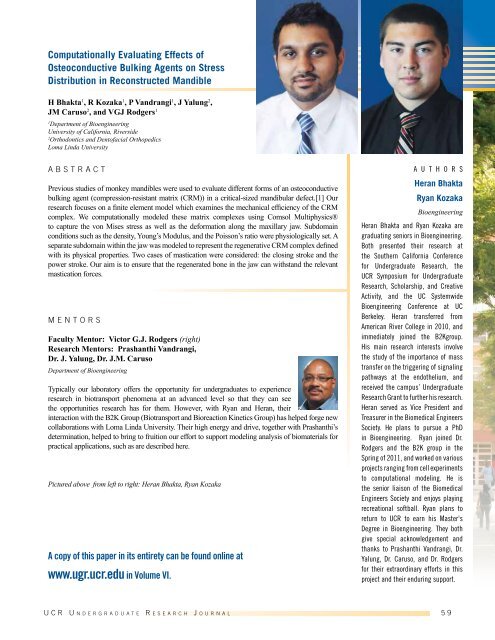Undergraduate Research Journal
Undergraduate Research Journal
Undergraduate Research Journal
You also want an ePaper? Increase the reach of your titles
YUMPU automatically turns print PDFs into web optimized ePapers that Google loves.
Computationally Evaluating Effects of<br />
Osteoconductive Bulking Agents on Stress<br />
Distribution in Reconstructed Mandible<br />
H Bhakta 1 , R Kozaka 1 , P Vandrangi 1 , J Yalung 2 ,<br />
JM Caruso 2 , and VGJ Rodgers 1<br />
1<br />
Department of Bioengineering<br />
University of California, Riverside<br />
2<br />
Orthodontics and Dentofacial Orthopedics<br />
Loma Linda University<br />
ABSTRACT<br />
Previous studies of monkey mandibles were used to evaluate different forms of an osteoconductive<br />
bulking agent (compression-resistant matrix (CRM)) in a critical-sized mandibular defect.[1] Our<br />
research focuses on a finite element model which examines the mechanical efficiency of the CRM<br />
complex. We computationally modeled these matrix complexes using Comsol Multiphysics®<br />
to capture the von Mises stress as well as the deformation along the maxillary jaw. Subdomain<br />
conditions such as the density, Young’s Modulus, and the Poisson’s ratio were physiologically set. A<br />
separate subdomain within the jaw was modeled to represent the regenerative CRM complex defined<br />
with its physical properties. Two cases of mastication were considered: the closing stroke and the<br />
power stroke. Our aim is to ensure that the regenerated bone in the jaw can withstand the relevant<br />
mastication forces.<br />
MentorS<br />
Faculty Mentor: Victor G.J. Rodgers (right)<br />
<strong>Research</strong> Mentors: Prashanthi Vandrangi,<br />
Dr. J. Yalung, Dr. J.M. Caruso<br />
Department of Bioengineering<br />
Typically our laboratory offers the opportunity for undergraduates to experience<br />
research in biotransport phenomena at an advanced level so that they can see<br />
the opportunities research has for them. However, with Ryan and Heran, their<br />
interaction with the B2K Group (Biotransport and Bioreaction Kinetics Group) has helped forge new<br />
collaborations with Loma Linda University. Their high energy and drive, together with Prashanthi’s<br />
determination, helped to bring to fruition our effort to support modeling analysis of biomaterials for<br />
practical applications, such as are described here.<br />
Pictured above from left to right: Heran Bhakta, Ryan Kozaka<br />
A copy of this paper in its entirety can be found online at<br />
www.ugr.ucr.edu in Volume VI.<br />
A U T H O R S<br />
Heran Bhakta<br />
Ryan Kozaka<br />
Bioengineering<br />
Heran Bhakta and Ryan Kozaka are<br />
graduating seniors in Bioengineering.<br />
Both presented their research at<br />
the Southern California Conference<br />
for <strong>Undergraduate</strong> <strong>Research</strong>, the<br />
UCR Symposium for <strong>Undergraduate</strong><br />
<strong>Research</strong>, Scholarship, and Creative<br />
Activity, and the UC Systemwide<br />
Bioengineering Conference at UC<br />
Berkeley. Heran transferred from<br />
American River College in 2010, and<br />
immediately joined the B2Kgroup.<br />
His main research interests involve<br />
the study of the importance of mass<br />
transfer on the triggering of signaling<br />
pathways at the endothelium, and<br />
received the campus’ <strong>Undergraduate</strong><br />
<strong>Research</strong> Grant to further his research.<br />
Heran served as Vice President and<br />
Treasurer in the Biomedical Engineers<br />
Society. He plans to pursue a PhD<br />
in Bioengineering. Ryan joined Dr.<br />
Rodgers and the B2K group in the<br />
Spring of 2011, and worked on various<br />
projects ranging from cell experiments<br />
to computational modeling. He is<br />
the senior liaison of the Biomedical<br />
Engineers Society and enjoys playing<br />
recreational softball. Ryan plans to<br />
return to UCR to earn his Master's<br />
Degree in Bioengineering. They both<br />
give special acknowledgement and<br />
thanks to Prashanthi Vandrangi, Dr.<br />
Yalung, Dr. Caruso, and Dr. Rodgers<br />
for their extraordinary efforts in this<br />
project and their enduring support.<br />
U C R U n d e r g r a d u a t e R e s e a r c h J o u r n a l 5 9














